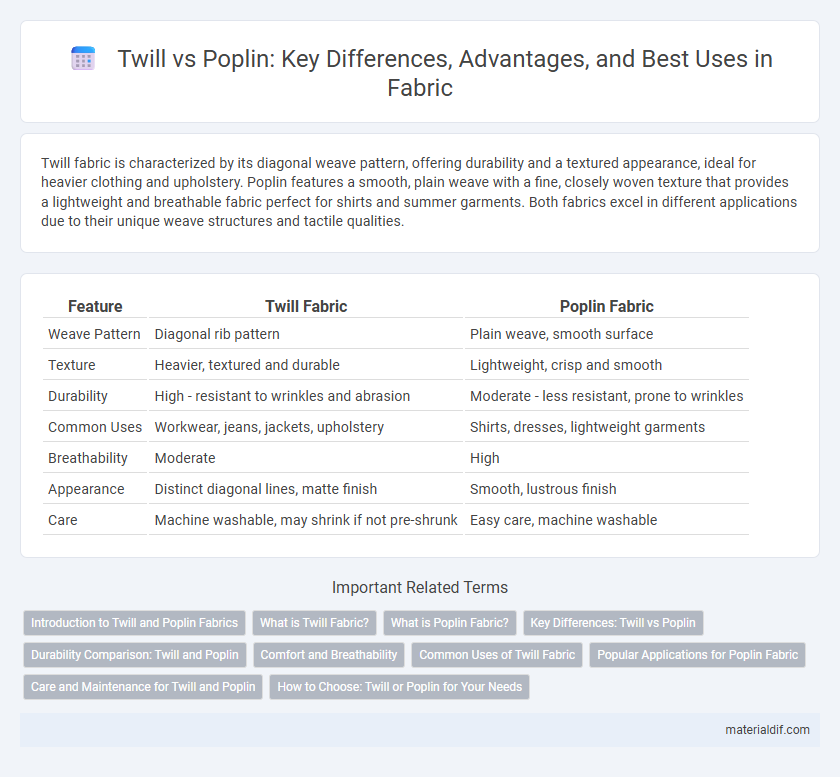Twill fabric is characterized by its diagonal weave pattern, offering durability and a textured appearance, ideal for heavier clothing and upholstery. Poplin features a smooth, plain weave with a fine, closely woven texture that provides a lightweight and breathable fabric perfect for shirts and summer garments. Both fabrics excel in different applications due to their unique weave structures and tactile qualities.
Table of Comparison
| Feature | Twill Fabric | Poplin Fabric |
|---|---|---|
| Weave Pattern | Diagonal rib pattern | Plain weave, smooth surface |
| Texture | Heavier, textured and durable | Lightweight, crisp and smooth |
| Durability | High - resistant to wrinkles and abrasion | Moderate - less resistant, prone to wrinkles |
| Common Uses | Workwear, jeans, jackets, upholstery | Shirts, dresses, lightweight garments |
| Breathability | Moderate | High |
| Appearance | Distinct diagonal lines, matte finish | Smooth, lustrous finish |
| Care | Machine washable, may shrink if not pre-shrunk | Easy care, machine washable |
Introduction to Twill and Poplin Fabrics
Twill fabric features a distinctive diagonal weave pattern that creates a durable, textured surface commonly used in jeans and workwear. Poplin fabric, characterized by its fine, closely woven plain weave, offers a smooth, lightweight texture ideal for shirts and summer garments. Both fabrics provide different tactile qualities and durability levels, influencing their suitability for various apparel and textile applications.
What is Twill Fabric?
Twill fabric is characterized by its distinctive diagonal weave pattern, created by passing the weft thread over one or more warp threads and then under two or more warp threads. This weaving technique results in a durable, densely woven fabric that is resistant to wrinkles and drapes well. Commonly made from cotton or wool, twill fabric is widely used in clothing such as jeans, jackets, and upholstery due to its strength and smooth surface.
What is Poplin Fabric?
Poplin fabric is a tightly woven cotton or cotton-blend material characterized by its fine horizontal ribbing, creating a smooth and durable surface. It offers a lightweight yet strong texture, making it ideal for shirts, dresses, and uniforms that require breathability and comfort. Poplin's balanced weave provides a subtle sheen and crisp feel, distinguishing it from coarser weaves like twill or denim.
Key Differences: Twill vs Poplin
Twill fabric is characterized by a distinctive diagonal weave pattern that enhances durability and hides stains, making it ideal for heavy-duty clothing like jeans and workwear. Poplin features a plain weave with a smooth texture and crisp feel, often used for lightweight shirts and dresses due to its breathable and wrinkle-resistant properties. The primary key difference between twill and poplin lies in their weave structures: twill's diagonal ribs provide greater strength and texture, while poplin's even plain weave offers softness and a more formal appearance.
Durability Comparison: Twill and Poplin
Twill fabric features a distinctive diagonal weave pattern that enhances its durability and resistance to wear, making it ideal for heavy-use applications such as workwear and upholstery. Poplin, with its plain weave and tighter construction, offers a smooth texture but is generally less durable than twill, being more suitable for lightweight clothing like dress shirts. The inherent strength of twill's weave results in higher tear resistance and longevity compared to the finer, smoother poplin fabric.
Comfort and Breathability
Twill fabric offers a distinctive diagonal weave that enhances durability while maintaining moderate breathability, making it comfortable for cooler climates and extended wear. Poplin features a tight, plain weave with a smooth texture, providing superior breathability and lightweight comfort ideal for warm weather. Both fabrics balance comfort and breathability differently, with poplin excelling in airflow and twill delivering sturdiness and softness.
Common Uses of Twill Fabric
Twill fabric, known for its distinctive diagonal weave, is commonly used in durable garments such as jeans, workwear, and upholstery due to its strength and resistance to wear. Its texture allows for better drape and wrinkle resistance, making it ideal for tailored suits, jackets, and outerwear. Twill's durability and versatility also extend to home textiles like curtains and cushions.
Popular Applications for Poplin Fabric
Poplin fabric is widely favored for making shirts, dresses, and lightweight jackets due to its smooth texture and durability. Its tight weave provides a crisp appearance ideal for formal and office wear. The fabric's breathability also makes it a popular choice for summer apparel and children's clothing.
Care and Maintenance for Twill and Poplin
Twill fabric requires gentle washing and low heat drying to maintain its diagonal weave and resist creases, making it ideal for durable, everyday garments. Poplin demands careful laundering in cold water and air drying to preserve its smooth, lightweight texture and prevent shrinkage or fabric distortion. Both fabrics benefit from ironing with a low to medium heat setting to avoid damage and extend garment longevity.
How to Choose: Twill or Poplin for Your Needs
Choosing between twill and poplin fabrics depends on the intended use and desired durability; twill offers a distinctive diagonal weave that provides greater strength and wrinkle resistance, ideal for workwear or outerwear. Poplin features a crisp, smooth texture with a plain weave that delivers lightweight breathability, making it suitable for shirts and summer garments. Consider twill for robust, long-lasting projects and poplin for fine, comfortable apparel with a polished appearance.
Twill vs Poplin Infographic

 materialdif.com
materialdif.com